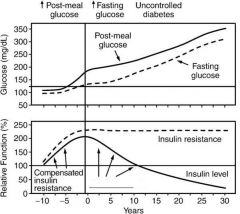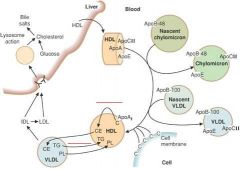![]()
![]()
![]()
Use LEFT and RIGHT arrow keys to navigate between flashcards;
Use UP and DOWN arrow keys to flip the card;
H to show hint;
A reads text to speech;
48 Cards in this Set
- Front
- Back
|
Conditions characterized by polyuria (large urine volume)
|
Diabetes (in the most general of terms)
|
|
|
Insulin deficiency and/or resistance
|
Diabetes Mellitus
When clinicians and patients use the term diabetes, they’re almost always referring to diabetes mellitus Mellitus refers to sweet urine. |
|
|
Vasopressin deficiency
Relatively rare |
Diabetes insipidus
Hypothalamus (central DI) or lack of renal response to it (nephrogenic DI). Insipidus refers to “tasteless” dilute urine. |
|
|
Most common forms
1. Insullin deficiency from B-cell destruction (5-10%) 2. Insulin resistance and deficiency (90-95%) |
Forms of Diabetes Mellitus
Other forms Gestational diabetes Monogenic forms: MODY, neonatal DM secondary to other diseases, medications. |
|
|
1. Fasting plasma glucose > 126 mg/dL (7.0 mmol/L)
2. Symptoms of diabetes plus random blood glucose > 200 mg/dL (11.1 mmol/L) 3. Two hour plasma glucose > 200 mg/dL (11.1 mmol/L) during an oral glucose test 4. Hemoglobin A1C > 6.5% |
Diagnosis for diabetes
HgA1C is not well spread diagnostic, though is on its way |
|
|
100 - 125 mg/dL
Fasting plasma glucose |
Impared fasting glucose (IFG)
Pre-diabetic state Note that the diagnosis of diabetes is based on glucose measurements. However, it’s important to keep in mind that diabetes is not simply a disease involving glucose! |
|
|
140-199 mg/dL
Oral glucose tolerance test |
Impaired glucose tolerance (IGT)
Pre-diabetic state Note that the diagnosis of diabetes is based on glucose measurements. However, it’s important to keep in mind that diabetes is not simply a disease involving glucose! |
|
|
Lipid and lipoprotein abnormalities
Atherosclerosis: coronary artery, cerebrovascular, peripheral vascular disease ~70% of diabetics die of CVD! |
The symptoms, signs, complications of
diabetes are not just related to glucose! |
|
|
1. Diabetes is not just a disorder of glucose
2. Diabetes mellitus is a disorder of insulin 3. Insulin is an anabolic hormone with pervasive effects on metabolism 4. The liver can only store so much glucose. 5. The body attempts to maintain plasma glucose levels between ~70 and 100 mg/dL 6. Diabetes is starvation in the midst of plenty. 7. Tight metabolic control reduces the long-term complications of diabetes mellitus 8. Type 2 diabetes mellitus arises from a continuum of subclinical pre-diabetic metabolic derangements 9. Insulin resistance, metabolic syndrome and type 2 diabetes constitute a global pandemic 10. Yesterday's biochemistry is today's medicine. |
Dr. Dave's ten concepts.
|
|
|
Large urine volume
Glucose gets spilled into the urine Above 180 mg/dL, kidneys place glucose into urine. Water follows. |
Symptoms of polyuria and dehydration
|
|
|
Explain the symptom:
Thirsty because of dehydration |
Polydipsia (thirst)
|
|
|
Explain the symptom:
Body is in starvation mode. |
Polyphagia (hunger)
|
|
|
Explain the symptom:
Body is in starvation mode. Lipids and body proteins are being broken down. |
Weight loss
|
|
|
Explain the symptom:
Body uses amino acids from body protein |
Weakness
|
|
|
Dehydration causes this symptom in the eyes.
|
Blurry vision
|
|
|
Retinopathy
Macular edema Sensory, motor, autonomic neuropathies. Nephropathy. |
Microvascular - arteriosclerosis
Primarily caused by chronically elevated blood glucose |
|
|
Coronary artery disease
Cerebrovascular disease Peripheral artery disease |
Macrovascular - atherosclerosis
Primarily caused by chronic blood lipid abnormalities |
|
|
High glucose concentration in blood
High ketone body concentration in blood. Occurs in type I diabetics |
Diabetic ketoacidosis - Type I Diabetes Mellitus
Hyperglycemia |
|
|
More subtle form of diabetes
Does not develop acidosis because body still produces insulin, enough to stave it off. |
Hyperglycemic hyperosmolar state - Type II Diabetes Mellitus
|
|
|
Decreased insulin
Increased glucagon HSL is activated FFA released to blood, which is bound to albumin. Primarily taken up by fat and muscle |
Causes elevated plasma FFA
|
|
|
Hyperinsulinemia is often found in pre-diabetics
Indicates they are in the resistance phase. May not be able to detect hyperglycemia |
Type II diabetes is found to have hyperinsulinemia.
Until the B-cells eventually die. |
|
|
In industrialized nations, there is less habitual physical activity.
Without physical activity, patient is not breaking down fats, but is continuously eating them. |
Results in obesity, a primary defect that results in Type II diabetes.
|
|
|
Hypertriglyceridemia
The liver can only convert 200-300 g of glucose into glycogen |
Any excess is stored as fat.
Reason why diabetics often have hypertriglyceridemia. An early sign of metabolic imbalance. - Fasting > 150 mg/dL |
|
|
1. Central obesity (by waist circumferance)
2. Hypertriglyceridemia: > 150 mg/dL (or specific medication) 3. Low HDL (< 40 mg/dL men, < 50 mg/dL female) 4. Hypertension >130/85 (or specific medication) 5. Fasting plasma glucose > 100 (or specific medication or diagnosis of type II diabetes mellitus) |
Metabolic syndrome
3 or more of the following. |
|
|
Plasma glucose levels are maintained in the starved state of a normal individual.
|
After two days, the body relies on fatty acids for fuel.
Glucose is still available. |
|
|
Type I diabetics experience ketoacidosis, due to high concentrations of ketone bodies.
|
Type II diabetics do not becasue there's enough insulin to keep everything in the balance.
Changes when B-cells are exhausted and die. |
|
|
Insulin deficiency caused by autoimmune destruction of pancreatic B-cells
Triggered by infections and genetic dispositions |
Etiology of type I DM
Defect on HLA region, MHC on chromosome 6. (50% of cases) |
|
|
Genetic predisposition and lifestyle factors
|
Type II Diabetes Mellitus
Polygenic, about 60 gene candidates. |
|
|
Muscle:
Decreased: - GLUT 4 receptors - Glucose uptake - AMPK - PPARy - FA oxidation Increased TAG accumulation Fatty Acid uptake |
Occurs when:
Adiponectin decreases Plasma FFA increases |
|
|
Liver:
Decreased: - FA oxidation - AMPK - PPARy Increased - Gluconeogenesis - TAG - VLDL - FA uptake |
Occurs when:
Adiponectin decreases Plasma FFA increases |
|
|
Pancreas
- Control insulin secretion Liver - Control glucose production and fatty acid oxidation Muscle - Glucose uptake pathway (insulin sensitivity) 4. Adipose - Fat mobilization, adiponectin secretion |
Pharmaceutical treatment strategies for type II diabetes
|
|
|
Increases:
1. Adiponectin 2. AMP kinase 3. Insulin sensitivity |
Thiazolidinediones
Target: PPARy Examples: - Avadnia (rosiglitazone) - Actos (pioglitazone) |
|
|
Decreases:
- Liver glucose Increases: - Insulin sensitivity |
Biguanides
Target: AMP kinase Example: Metformin. |
|
|
Decreases:
1. Intestinal absorption of starch and saccharides |
alpha-glucosidase inhibitors
Target: a-glucosidase Examples: - Precos (acarbose) - Glyset (miglitol) |
|
|
Increases insulin secretion
Blocks KATP channel. |
Meglitinides
Target: ATP-sensitive K+ channel/SUR Examples - repaglinide - nateglinide |
|
|
Block KATP channel
Increase insulin secretion |
Sulfonylureas (1950s)
Target: ATP-sensitive K+ channel/SUR Examples - tolbutamide - glipizide - glyburide |
|
|
Insulin replacement
|
Insulin
Target: Insulin receptors, many pathways Examples - Regular NPH - Lente |
|
|
KATP channel remains open
|
Diabetes
Can be treated with sulfonylureas/meglitinides (close the channel -> trigger release of insulin) |
|
|
KATP channels remain closed
|
Persistant Hypoglycemia and hyperinsulinemia in infancy.
Cannot be treated with sulfonylureas/meglitinides |
|
|
Normal individual
Increased TAG-VLDL -> CETP -> TAG rich HDL -> Hepatic lipase = Increased clearance Decreased HDL levels |
Diabetic person
Increased TAG-VLDL -> CETP -> TAG rich LDL -> Hepatic lipase = Small-dense atherogenic LDL - Increases with higher glucose and FFA's - Damaged by oxidation |
|
|
What causes the remodeling of HDL and LDL via Cholesterol Ester Transferase Protein (CETP)?
|
Increased levels of triglycerides (TAGs)
|
|

|

|
|

|

|
|

Which enzyme is responsible for remodeling HDL and LDL when TAGs are highly elevated
|

Cholesterol Ester Transferase Protein
|
|
|
Therapy sufficient to alleviate acute symptoms
|
Standard control
|
|
|
Therapy sufficient to return plasma glucose and HbA1C levels to near normal levels.
|
Tight control.
Problem - if not correctly titrated, may cause problems due to hypoglycemia. |
|
|
Fasting glucose: 90-130 mg/dL
Post-prandial glucose (2hr): <180 mg/dL HbA1C: <7.0, as close to 6.5 as possible. |
Treatment goals for insulin replacement
|
|
|
Out of these four metabolic derangements, only two classify as 'pre-diabetes'
1. Insulin resistance 2. Glucose intolerance 3. Metabolic syndrome 4. Type 2 diabetes |
Glucose intolerance
Metabolic syndrome |

